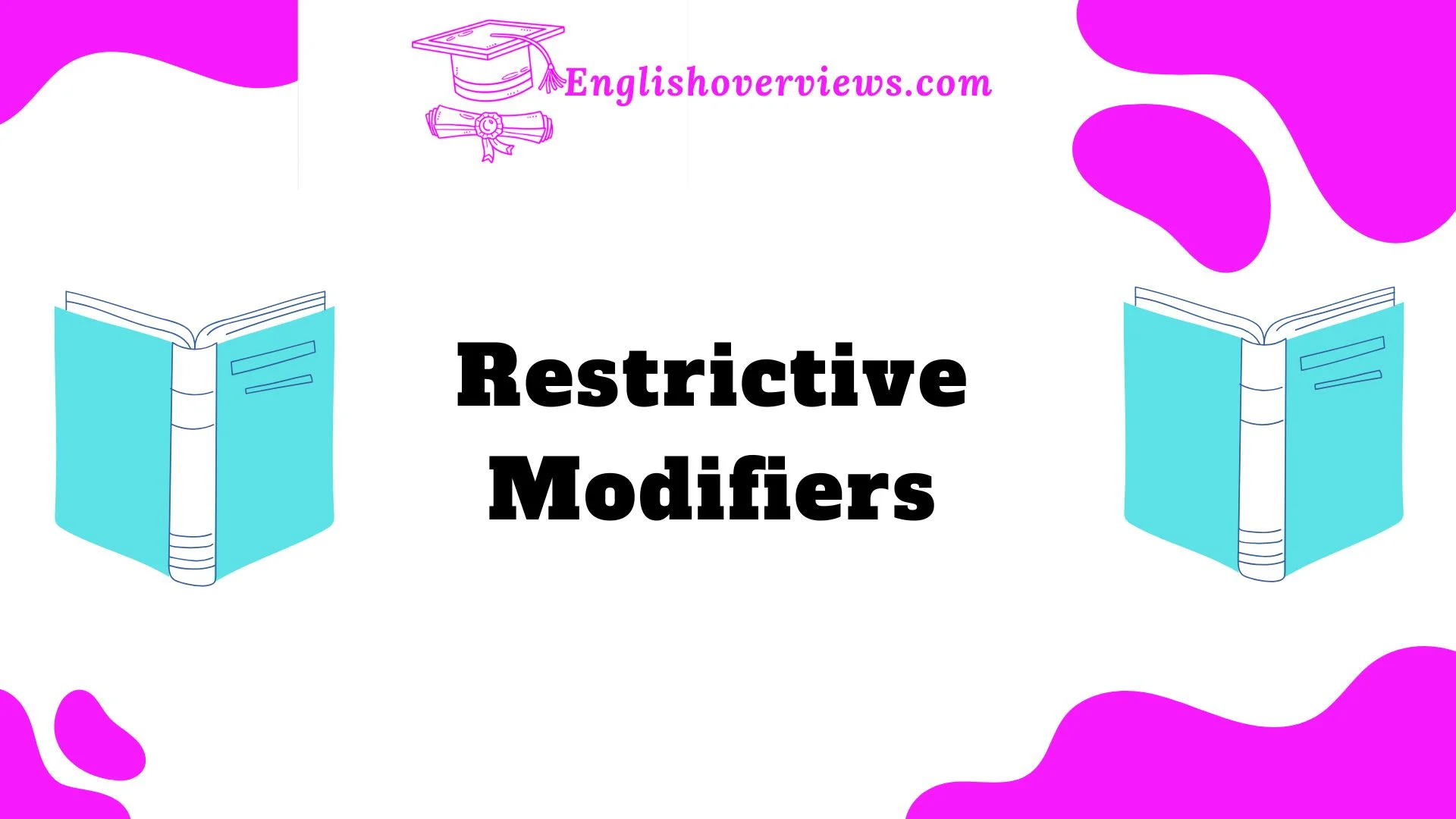Have you ever read a sentence and felt confused about what it actually means? Chances are, a modifier was misplaced or incorrectly used. Restrictive modifiers play a crucial role in sentence clarity, ensuring every word serves a purpose. Misusing them can turn a straightforward sentence into a riddle.
For instance, consider this: “The students who study regularly excel in exams.” Without the restrictive modifier (who study regularly), the sentence loses its specific meaning.
Whether you’re a student, writer, or professional, mastering restrictive modifiers will improve your communication skills and help you convey ideas more precisely.
Let’s get started on this grammar journey and make sentence clarity second nature!
What Are Restrictive Modifiers?
At their core, restrictive modifiers are words, phrases, or clauses that limit or specify the meaning of a sentence. They are essential for identifying which person, thing, or idea you’re talking about.
Definition and Key Characteristics
- Restrictive modifiers are essential to the sentence’s meaning.
- They cannot be removed without changing the core meaning.
- They are not set off by commas.
Example:
- The book on the top shelf is mine.
- The phrase on the top shelf specifies which book is being referred to.
Why Are Restrictive Modifiers Important?
They help:
- Avoid ambiguity.
- Clarify your message.
- Provide necessary details.
Restrictive vs. Nonrestrictive Modifiers: Quick Comparison
| Feature | Restrictive Modifier | Nonrestrictive Modifier |
| Purpose | Essential for meaning | Adds extra information |
| Punctuation | No commas | Separated by commas |
| Example | The dog that barks loudly annoys the neighbors. | The dog, which barks loudly, annoys the neighbors. |
Real-World Example:
In legal writing, restrictive modifiers can change the entire meaning of a clause.
- “Residents who own property will receive tax benefits.”
- Without who own property, the sentence implies all residents, not just property owners.
Understanding restrictive modifiers isn’t just about grammar; it’s about clear and precise communication.
The Key Differences Between Restrictive and Nonrestrictive Modifiers
To master restrictive modifiers, you must first understand how they compare to nonrestrictive modifiers.
1. Defining the Differences
- Restrictive Modifiers: Essential for sentence meaning.
- Nonrestrictive Modifiers: Provide extra details but are not necessary for the core message.
Example:
- Restrictive: The cake that John baked was delicious.
- Nonrestrictive: The cake, which John baked yesterday, was delicious.
2. Key Identifiers
- Restrictive modifiers are not surrounded by commas.
- Nonrestrictive modifiers are always surrounded by commas.
3. Common Misunderstandings
- Mistake: Overusing commas with restrictive modifiers.
- Mistake: Omitting commas with nonrestrictive modifiers.
Quick Tip:
If you can remove the modifier without losing the sentence’s meaning, it’s nonrestrictive.
4. Table: Side-by-Side Comparison
| Aspect | Restrictive Modifier | Nonrestrictive Modifier |
| Punctuation | No commas | Separated by commas |
| Removable? | No | Yes |
| Impact on meaning | Changes meaning if removed | Adds extra detail |
Case Study:
A marketing email read:
- “Customers who purchased in June will receive a discount.”
When rephrased as: - “Customers, who purchased in June, will receive a discount.”
The entire meaning changed! The first sentence refers to a specific group; the second implies all customers.
The devil is in the details, and those details often lie in modifiers.
The Role of Punctuation in Restrictive and Nonrestrictive Modifiers
Punctuation, specifically commas, plays a crucial role in distinguishing between restrictive and nonrestrictive modifiers.
1. The Power of the Comma
- Restrictive modifiers do not use commas.
- Nonrestrictive modifiers require commas.
Example:
- The teacher who loves math gave extra homework.
- The teacher, who loves math, gave extra homework.
2. Common Punctuation Errors
- Using commas with restrictive modifiers.
- Omitting commas with nonrestrictive modifiers.
3. Quick Punctuation Guide
| Modifier Type | Punctuation Rule |
| Restrictive | No commas |
| Nonrestrictive | Use commas |
4. Real-World Example:
Legal contracts often rely heavily on punctuation.
- “Assets that are liquid will be distributed equally.”
- “Assets, which are liquid, will be distributed equally.”
The difference could mean a multi-million-dollar mistake.
Pro Tip:
When in doubt, read the sentence aloud. If the modifier feels like a side note, use commas. If it feels essential, don’t.
Common Pitfalls and Errors When Using Modifiers
1. Misplaced Modifiers
These occur when a modifier is too far from the word it describes.
Example:
- Incorrect: She served sandwiches to the guests on paper plates.
- Correct: She served sandwiches on paper plates to the guests.
2. Dangling Modifiers
These modifiers have no clear word to modify.
Example:
- Incorrect: Driving to work, the fog was thick.
- Correct: While driving to work, I noticed the fog was thick.
3. Overusing Restrictive Modifiers
Too many modifiers can clutter a sentence.
Quick Fix Tip:
Focus on one key modifier per sentence.
4. Checklist for Avoiding Modifier Mistakes
- ✅ Is the modifier close to the word it describes?
- ✅ Does it use correct punctuation?
- ✅ Can it be removed without changing meaning?
FAQs About Restrictive Modifiers
1. What is the main purpose of restrictive modifiers?
Restrictive modifiers clarify and limit the meaning of a noun.
2. Are commas ever used with restrictive modifiers?
No, restrictive modifiers are not separated by commas.
3. How can I identify a restrictive modifier?
If removing it changes the meaning, it’s restrictive.
4. Can a single word act as a restrictive modifier?
Yes! Words like only, just, or exactly can be restrictive.
5. Are dangling modifiers the same as misplaced modifiers?
No. Dangling modifiers lack a clear subject, while misplaced modifiers are just in the wrong spot.
This guide tackled restrictive modifiers in-depth, from definitions to punctuation and real-world applications. Master these rules, and your writing will become clearer, more precise, and professional. Happy writing! 🚀
Conclusion
Mastering restrictive modifiers isn’t just about perfect grammar-it’s about clear and effective communication. These essential tools help ensure your sentences convey precise meaning without ambiguity.
Whether you’re writing an academic paper, a business proposal, or even a casual email, understanding the difference between restrictive and nonrestrictive modifiers can make or break your message.
Key Takeaways:
- Restrictive modifiers are essential and should not be set off by commas.
- Nonrestrictive modifiers add extra detail and require commas.
- Punctuation plays a vital role in distinguishing these two types.
- Avoid misplaced and dangling modifiers to maintain sentence clarity.
In writing, precision equals power. Every word must earn its place, and every modifier should serve a clear purpose. Take the time to proofread, test your sentences aloud, and ensure your modifiers are doing their job effectively.
As Mark Twain once said, “The difference between the almost right word and the right word is really a large matter-it’s the difference between the lightning bug and the lightning.”

English Overviews is a resourceful website dedicated to providing valuable content related to grammar and vocabulary.Babar Naeem has made notable contributions, sharing insights on various subjects, including WordPress themes and plugins. The primary goal of the site is to help users improve their English language skills effectively.











